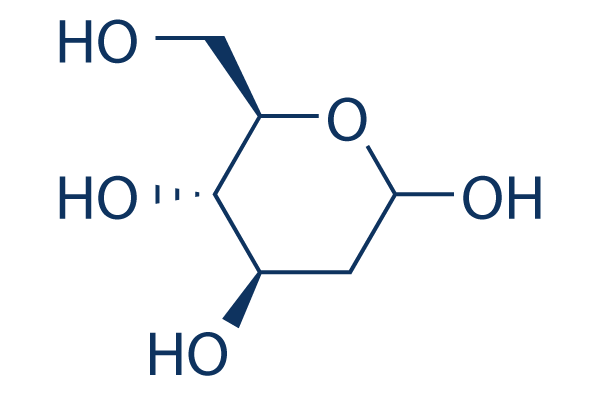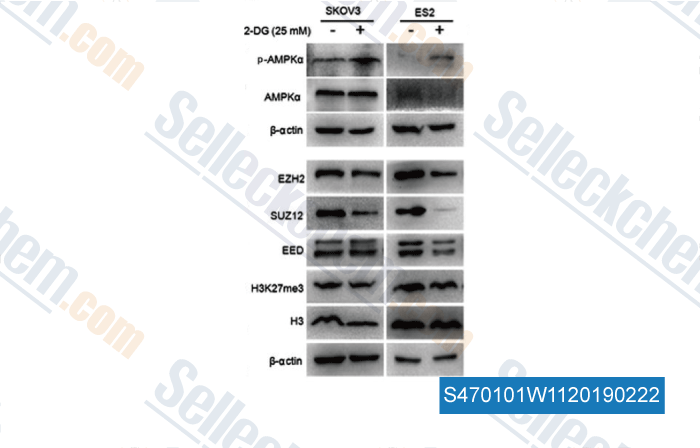|
受注:045-509-1970 |
技術サポート:[email protected] 平日9:00〜18:00 1営業日以内にご連絡を差し上げます |
化学情報

|
Synonyms | 2-deoxyglucose, NSC 15193, 2-Deoxy-D-arabino-hexose, D-Arabino-2-deoxyhexose | Storage (From the date of receipt) |
3 years -20°C powder 1 years -80°C in solvent |
| 化学式 | C6H12O5 |
|||
| 分子量 | 164.16 | CAS No. | 154-17-6 | |
| Solubility (25°C)* | 体外 | DMSO | 32 mg/mL (194.93 mM) | |
| Water | 32 mg/mL (194.93 mM) | |||
| Ethanol | 8 mg/mL (48.73 mM) | |||
|
* <1 mg/ml means slightly soluble or insoluble. * Please note that Selleck tests the solubility of all compounds in-house, and the actual solubility may differ slightly from published values. This is normal and is due to slight batch-to-batch variations. |
||||
溶剤液(一定の濃度)を調合する
生物活性
| 製品説明 | 2-DG (2-Deoxy-D-glucose), an analog of glucose, is a glycolytic inhibitor with antiviral activity. 2-Deoxy-D-glucose induces apoptosis and inhibits Herpes Simplex Virus type-1 (HSV-1) receptor expression. |
|---|---|
| in vitro | 2-Deoxy-D-glucose(2-DG) activates AKT function through phosphatidylinositol 3-kinase (PI3K) and is independent of glycolysis or mTOR inhibition. 2-DG treatments disrupts the binding between insulin-like growth factor 1 (IGF-1) and IGF-binding protein 3 (IGFBP3) so that the free form of IGF-1 could be released from the IGF-1·IGFBP3 complex to activate IGF-1 receptor (IGF1R) signaling. 2-DG-induced activation of many survival pathways can be jointly attenuated through IGF1R inhibition. 2-DG also induces time- and dose-dependent ERK phosphorylation[1]. 2-DG is readily transported into cells and is phosphorylated by hexokinase, but cannot be metabolized further and accumulates in the cell. This leads to ATP depletion and the induction of cell-death[2]. 2DG significantly suppresses proliferation, causes apoptosis and reduces migration of murine endothelial cells, inhibiting formation of lamellipodia and filopodia and causing disorganization of F-actin filaments in murine endothelial cell[5]. |
| in vivo | Treatment of cancer patients with relatively high doses of 2-DG (greater than 200 mg/kg) was largely ineffective in managing tumor growth. Side effects of 2-DG included elevated blood glucose levels, progressive weight loss with lethargy, and behavioral symptoms of hypoglycemia[2]. 2-DG enhances isoflurane-induced loss of righting reflex in mice. By reducing metabolism, 2-DG treatment can decrease body temperature in rodent, enhancing sensitivity to anesthetics[3]. 2-DG diet significantly increased serum ketone body level and brain expression of enzymes required for ketone body metabolism. The 2-DG-induced maintenance of mitochondrial bioenergetics was paralleled by simultaneous reduction in oxidative stress. Further, 2-DG treated mice exhibited a significant reduction of both amyloid precursor protein (APP) and amyloid beta (Aβ) oligomers, which was paralleled by significantly increased α-secretase and decreased γ-secretase expression, indicating that 2-DG induced a shift towards a non-amyloidogenic pathway. 2-DG increased expression of genes involved in Aβ clearance pathways, degradation, sequestering, and transport. Concomitant with increased bioenergetic capacity and reduced β-amyloid burden, 2-DG significantly increased expression of neurotrophic growth factors, BDNF and NGF, thus reduces pathology in female mouse model of Alzheimer's disease[4]. |
プロトコル(参考用のみ)
| 細胞アッセイ | 細胞株 | H460 or H157 cells |
|---|---|---|
| 濃度 | 5 mM | |
| 反応時間 | 48 h | |
| 実験の流れ | 2×103 H460 or H157 cells are seeded in 96-well cell culture plates. Cells are treated with 5 mM 2-DG only, 5 or 10 μM IGF1R inhibitor II only, or a combination of 2-DG and IGF1R inhibitor II. Cell growth inhibition is determined after 48 h by the CellTiter 96® AQueous nonradioactive cell proliferation assay. |
|
| 動物実験 | 動物モデル | Adult C57BL/6J mice |
| 投薬量 | 1000 mg/kg | |
| 投与方法 | i.p. |
参考
カスタマーフィードバック

-
Data from [Data independently produced by , , Int J Oncol, 2018, 52(6):1899-1911]
Selleckの高級品が、幾つかの出版された研究調査結果(以下を含む)で使われた:
| RIG-I is an intracellular checkpoint that limits CD8+ T-cell antitumour immunity [ EMBO Mol Med, 2024, 10.1038/s44321-024-00136-9] | PubMed: 39322862 |
| Tumor-derived Exosomal ENO2 Modulates Polarization of Tumor-associated Macrophages through Reprogramming Glycolysis to Promote Progression of Diffuse Large B-cell Lymphoma [ Int J Biol Sci, 2024, 20(3):848-863] | PubMed: 38250157 |
| Lactylation drives hCG-triggered luteinization in hypoxic granulosa cells [ Int J Biol Macromol, 2024, 280(Pt 4):135580] | PubMed: 39322166 |
| Dependence of NPPS creates a targetable vulnerability in RAS-mutant cancers [ Acta Pharmacol Sin, 2024, ] | PubMed: 39506063 |
| Paeonol prevents sepsis-associated encephalopathy via regulating the HIF1A pathway in microglia [ Int Immunopharmacol, 2024, 143(Pt 1):113287] | PubMed: 39362015 |
| Analysis of GCRV Pathogenesis and Therapeutic Measures Through Proteomic and Metabolomic Investigations in GCRV-Infected Tissues of Grass Carp (Ctenopharyngodon idella) [ Int J Mol Sci, 2024, 25(21)11852] | PubMed: 39519403 |
| Hyperglycemia-induced Sirt3 downregulation increases microglial aerobic glycolysis and inflammation in diabetic neuropathic pain pathogenesis [ CNS Neurosci Ther, 2024, 30(8):e14913] | PubMed: 39123294 |
| SUMO3 inhibition by butyric acid suppresses cell viability and glycolysis and promotes gemcitabine antitumor activity in pancreatic cancer [ Biol Direct, 2024, 19(1):74] | PubMed: 39183358 |
| GDF15 ameliorates sepsis-induced lung injury via AMPK-mediated inhibition of glycolysis in alveolar macrophage [ Respir Res, 2024, 25(1):201] | PubMed: 38725041 |
| Multi-omics and immunogenomics analysis revealed PFKFB3 as a targetable hallmark and mediates sunitinib resistance in papillary renal cell carcinoma: in silico study with laboratory verification [ Eur J Med Res, 2024, 29(1):236] | PubMed: 38622715 |
長期の保管のために-20°Cの下で製品を保ってください。
人間や獣医の診断であるか治療的な使用のためにでない。
各々の製品のための特定の保管と取扱い情報は、製品データシートの上で示されます。大部分のSelleck製品は、推薦された状況の下で安定です。製品は、推薦された保管温度と異なる温度で、時々出荷されます。長期の保管のために必要とされてそれと異なる温度で、多くの製品は、短期もので安定です。品質を維持するが、夜通しの積荷のために最も経済的な貯蔵状況を用いてあなたの送料を保存する状況の下に、製品が出荷されることを、我々は確実とします。製品の受領と同時に、製品データシートの上で貯蔵推薦に従ってください。
